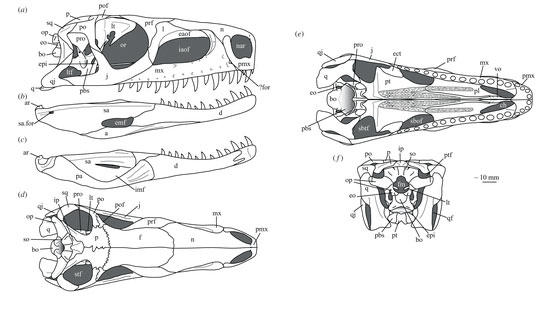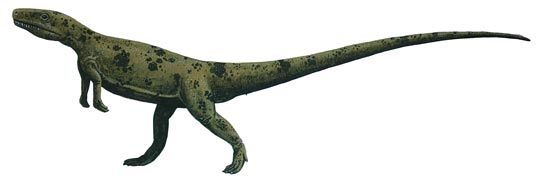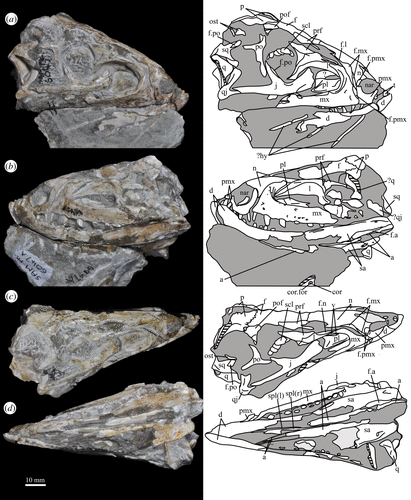A Fresh Look at Euparkeria
The fossilised remains of a little, lithe reptile that wandered South Africa during the Middle Triassic have come into the spotlight more than a hundred years after they were first scientifically described. The fossils represent the taxon Euparkeria (pronounced Yoo-park-air-ree-ah) and they are regarded as highly significant in terms of plotting the evolution of tetrapods.
Formally named and described in 1913 (Robert Broom), Euparkeria is phylogenetically regarded as a basal member of the Archosauria. As such, by studying the fossil remains of this animal, palaeontologists can gain a better understanding of the evolution of the archosaurs – a diverse group of tetrapods that includes the crocodilians, birds and of course, the dinosaurs.
A Life Reconstruction of Euparkeria (Euparkeria capensis)
Picture credit: Everything Dinosaur
Represented By More Than Ten Fossil Specimens
The fossils all come from a single locality, Aliwal North on the Eastern Cape and Free State Province boundary in South Africa. The fossilised bones having been collected from a solitary stone quarry, adjacent to a small stream.
Measuring around sixty centimetres in length (the tail made up more than half the body length), Euparkeria is known from at least ten specimens. This material was extensively reviewed in 1965, but over the last six decades or so, there have been huge advances in fossil bone imaging techniques and the researchers led by Roland B. Sookias (Museum für Naturkunde in Berlin), subjected Euparkeria material to CT scanning at the Evolutionary Studies Institute, University of the Witwatersrand, Johannesburg.
The Research Has Enabled Detailed Diagrams of the Skull of Euparkeria to be Compiled

Picture credit: Sookias et al (Royal Society Open Science)
Examining the Skull of Euparkeria
The CT scans enabled the scientists to describe the skull and jaw of Euparkeria in much greater detail than ever before. Anatomical features previously unclear, are fully described for the first time. The researchers were able to examine the palate, determine the number of teeth in the premaxilla (4 teeth in each premaxilla) and reconstruct the braincase. The modular composition of the skull would have ensured that the cranium was quite flexible, adapted to coping with the stress of prey struggling in the jaws.
The study, published by the Royal Society Open Science, confirms Euparkeria as a major advance in tetrapod evolution and helps to place the crown Archosauria in greater context informing palaeontologists about the early stages of archosaur evolution. Euparkeria most probably spent most of its time on all fours, a comparison of forelimb versus hindlimb length suggests that it was a facultative biped (usually walking on all fours but capable of walking as a biped when it needed to). It was one of the first reptiles capable of running on just its hind legs.
Skull of Euparkeria capensis Specimen (SAM-PK-6047A) with Line Drawings
Picture credit: Sookias et al (Royal Society Open Science)
Euparkeria from the Triassic
Euparkeria, which lived approximately 245 million years ago, shows a number of anatomical advances including an increase in brain size with improved senses, upright locomotion and a likely rapid metabolism placing this taxon in a pivotal position between ancestral diapsids the very first members of the Archosauria.
The scientific paper: “The craniomandibular anatomy of the early archosauriform Euparkeria capensis and the dawn of the archosaur skull” by Roland B. Sookias, David Dilkes, Gabriela Sobral, Roger M. H. Smith, Frederik P. Wolvaardt, Andrea B. Arcucci, Bhart-Anjan S. Bhullar and Ingmar Werneburg published by the Royal Society Open Science.
The Everything Dinosaur website: Everything Dinosaur.








Leave A Comment